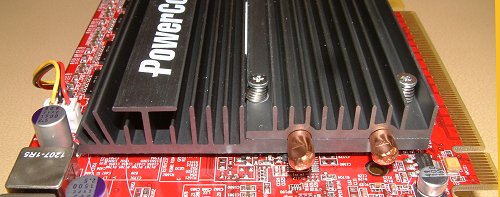Card appearance

A completely silent X800 XL card from PowerColor? The above picture suggests so, but PowerColor has strapped a fan on to the back. There's good reasons to do so, and we'll discuss them further down the page. Forgetting the cooling for a second, PowerColor's 512MB-equipped card follows the form set by the reference design. Part of that is the use of dual-DVI outputs, as seen on the far left. You'll also notice the PCI-Express power connector on the right-hand side that was introduced with the reference design. Extra DRAM devices forced a re-jig in the original 256MB card's power design, so ATI's played it safe and introduced external power.

Here's a better shot of the 6-pin power connector and the heatpipe-driven approach used on this card. The GPU's still located in the same place, on the front of the card, but the heat produced is absorbed and radiated out by large heatsink. Adding to the cooling are two copper heatpipes that transfer part of the generated heat around to the back. The front-mounted heatsink became very warm to the touch when the GPU was placed under load, yet not warm enough to impact upon card stability, be it 2D or 3D work.

The heatsink is a two-piece affair, with the copper pipes firmly sandwiched in between. It's worth remembering that ATI's RADEON X800 XL GPU (RV430) is based on a 110nm manufacturing process, runs at 400MHz core, and carries a full complement of 16 rendering pipelines.

PowerColor's SCS2 (Silent Cooling System 2) is the name given to the overall cooling apparatus. As you can see, it's not quite silent. The aforementioned heat is pulled around to the back of the card by the heatpipes and transmitted to the heatsink on the rear. The accumulated heat is then pushed away from the card by the temperature-controlled fan that has a cool blue LED inside. It's worth noting that the rear heatsink remained far cooler than the GPU side's. It makes you then wonder just how much heat is being wicked away. Ideally, one would also have an 80mm exhaust fan just above the card that would expel out the heat pushed out by the card. It's worth reiterating, however, that there were zero stability-related problems in using the SCS2-equipped card in a case without additional ventilation. Further, the fan is almost inaudible during 3D load and doesn't rise in pitch or overall volume after extended gaming. Nice and quiet; just how we like it.









